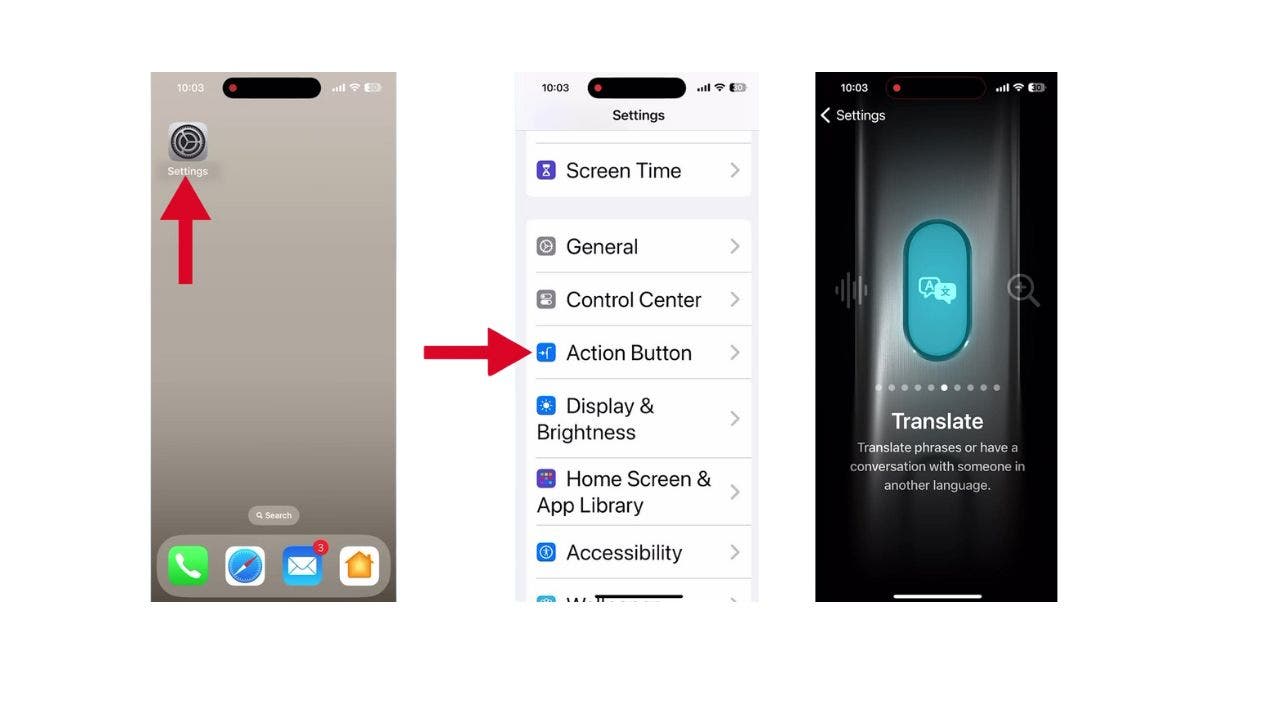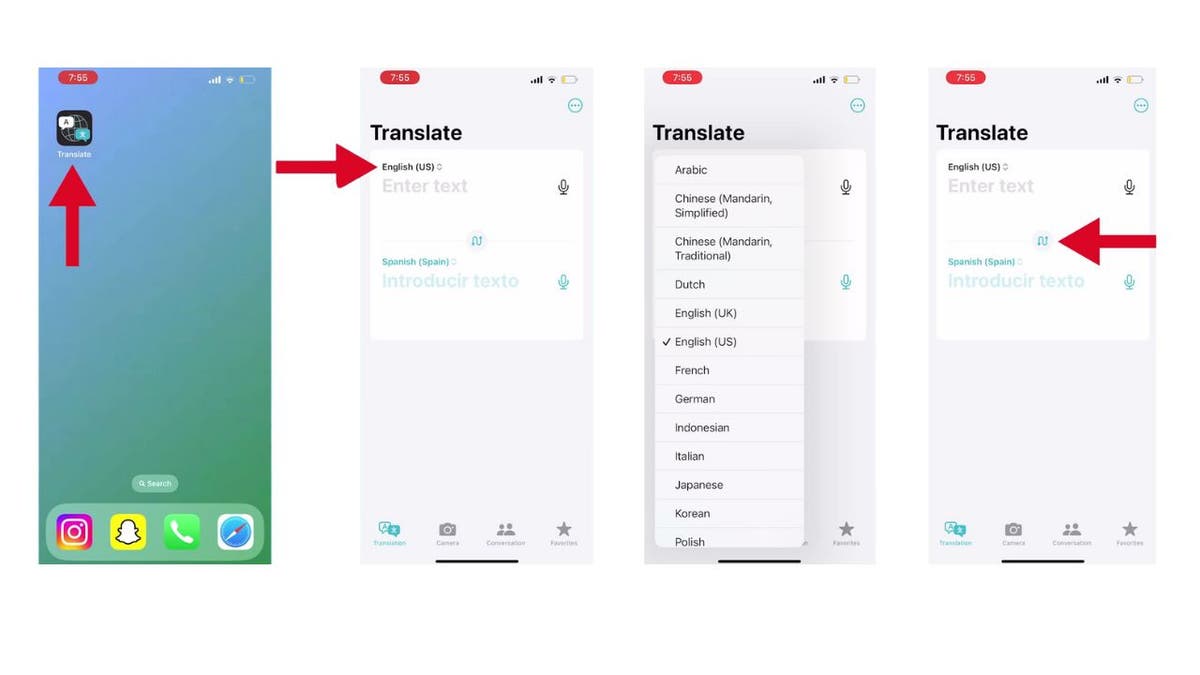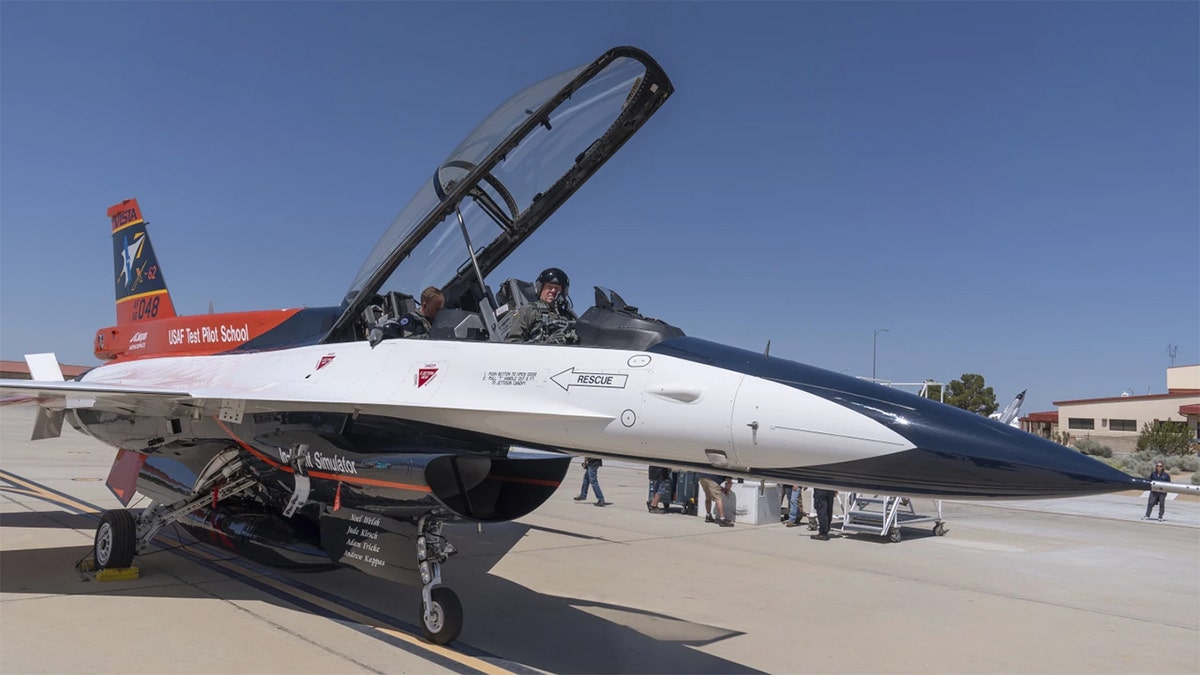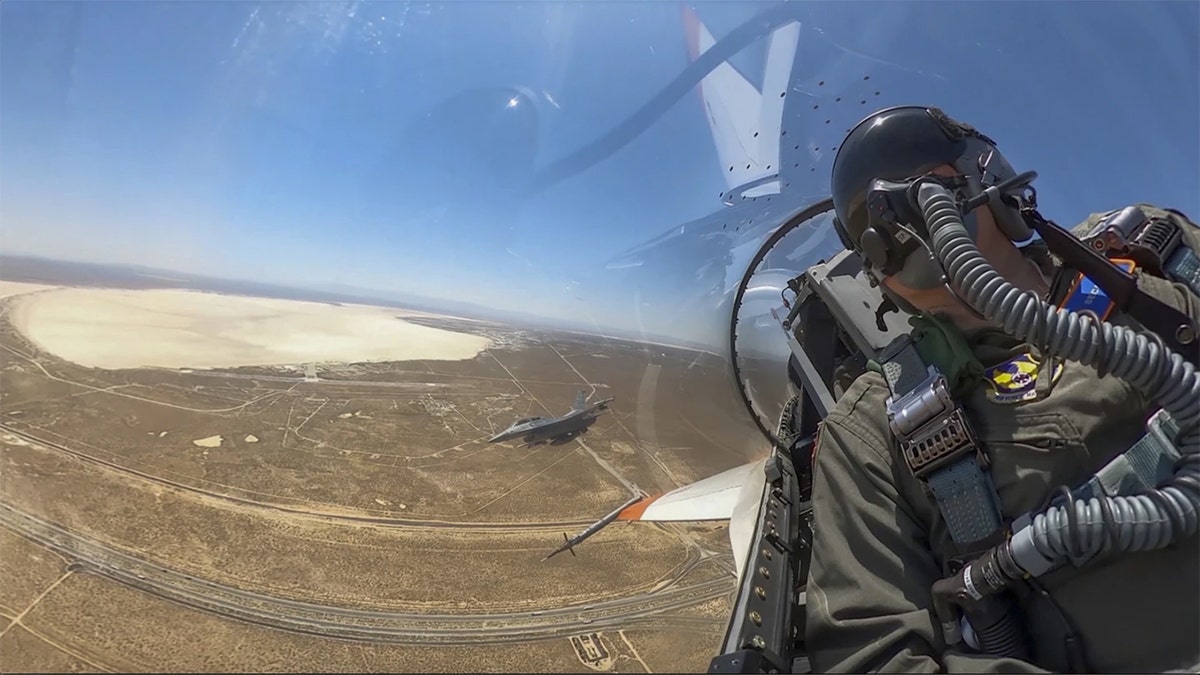Technology
How to turn your iPhone into instant foreign language translator

In today’s interconnected world, the ability to communicate across language barriers is more important than ever. Apple has recognized this need and, in a recent iOS update, introduced a nifty feature that allows you to translate languages instantly without even opening the Translate app.
This feature utilizes the “Dynamic Island,” a pill-shaped area at the top of the iPhone screen that can change size and shape to accommodate various types of alerts, notifications and interactions, turning it into a kind of front-and-center information hub. The Dynamic Island feature is available on the iPhone 15 models, which includes the iPhone 15, iPhone 15 Plus, iPhone 15 Pro and iPhone 15 Pro Max.
CLICK TO GET KURT’S FREE CYBERGUY NEWSLETTER WITH SECURITY ALERTS, QUICK VIDEO TIPS, TECH REVIEWS AND EASY HOW-TO’S TO MAKE YOU SMARTER
Translate feature on iPhone (Kurt “CyberGuy” Knutsson)
MORE: TOP AFFORDABLE CELLPHONE PLANS
How to set up the Translate Action Button on iPhone 15
Getting started is simple. Here’s how you can set up the Translate option using the Action Button on your iPhone:
- Open Settings on your iPhone
- Scroll down and tap the Action Button
- Swipe through the carousel of actions until you get to Translate

Steps to set up the Translate Action Button (Kurt “CyberGuy” Knutsson)
MORE: HOW TO UPDATE YOUR PASSCODE ON YOUR IPHONE
How to use the Translate Action Button on iPhone 15
Once you’ve set it up, using it is just as easy:
- On the upper left side of your iPhone 15, press and hold the Action Button for a moment.
- Continue holding the Action Button until the Dynamic Island changes to display “English, Listening”.
- Start speaking the phrase you want to translate.
- After a moment, the translated text will appear on your screen and will be said aloud.
- If you need to hear the translation again, simply tap the play button.
Make sure to release the Action Button after the Dynamic Island shows “English, Listening” to ensure the feature works correctly.

Steps to use the Translate Action Button (Kurt “CyberGuy” Knutsson)
MORE: HOW TO CREATE OR LEAVE GROUP TEXT ON YOUR IPHONE
How to adjust your translation settings
While you can’t change the Translate settings directly from the Action Button, you can still customize your experience within the Translate app itself:
- Open the Translate app.
- Tap on the top or bottom language listed, and a list of languages will appear for you to choose from.
- You can also toggle whether you want to translate from English to another language or vice versa.

Steps to adjust your translation settings (Kurt “CyberGuy” Knutsson)
MORE: 8 WAYS TO LOCK UP YOUR PRIVATE STUFF ON YOUR IPHONE
Kurt’s key takeaways
Apple’s latest update is more than just a technical enhancement. It’s a step toward a world where language differences are no longer a barrier to communication. Whether you’re traveling abroad, learning a new language or connecting with friends and family across the globe, the ability to translate on the fly is a game-changer. It’s a testament to how technology can bring us closer together, making the vast world just a little bit smaller.
Have you ever found yourself in a situation where instant translation would have made a significant difference? Let us know by writing us at Cyberguy.com/Contact.
For more of my tech tips & security alerts, subscribe to my free CyberGuy Report Newsletter by heading to Cyberguy.com/Newsletter.
Ask Kurt a question or let us know what stories you’d like us to cover.
Answers to the most asked CyberGuy questions:
Copyright 2024 CyberGuy.com. All rights reserved.

Technology
Randy Travis gets his voice back in a new Warner AI music experiment
/cdn.vox-cdn.com/uploads/chorus_asset/file/25434709/1301841063.jpg)
For the first time since a 2013 stroke left country singer Randy Travis unable to speak or sing properly, he has released a new song. He didn’t sing it, though; instead, the vocals were created with AI software and a surrogate singer.
The song, called “Where That Came From,” is every bit the kind of folksy, sentimental tune I came to love as a kid when Travis was at the height of his fame. The producers created it by training an unnamed AI model, starting with 42 of his vocal-isolated recordings. Then, under the supervision of Travis and his career-long producer Kyle Lehning, fellow country singer James DuPre laid down the vocals to be transformed into Travis’ by AI.
Besides being on YouTube, the song is on other streaming platforms like Apple Music and Spotify.
The result of Warner’s experiment is a gentle tune that captures Travis’ relaxed style, which rarely wavered far from its baritone foundation. It sounds like one of those singles that would’ve hung around the charts long enough for me to nervously sway to once after working up the gumption to ask a girl to dance at a middle school social. I wouldn’t say it’s a great Randy Travis song, but it’s certainly not the worst — I’d even say I like it.
Dustin Ballard, who runs the various incarnations of the There I Ruined It social media account, creates his AI voice parodies in much the same way as Travis’ team, giving birth to goofy mash-ups like AI Elvis Presley singing “Baby Got Back” or synthetic Johnny Cash singing “Barbie Girl.”
It would be easy to sound the alarm over this song or Ballard’s creations, declaring the death of human-made music as we know it. But I’d say it does quite the opposite, reinforcing what tools like an AI voice clone can do in the right hands. Whether you like the song or not, you have to admit that you can’t get something like this from casual prompting.
Cris Lacy, Co-president of Warner Music Nashville, told CBS Sunday Morning that AI voice cloning sites produce approximations of artists like Travis that don’t “sound real, because it’s not.” She called the label’s use of AI to clone Travis’ voice “AI for good.”
Right now, Warner can’t really do much about AI clones that it feels don’t fall under the heading of “AI for good.” But Tennessee’s recently-passed ELVIS Act, which goes into effect on July 1st, would allow labels to take legal action against those using software to recreate an artists’ voice without permission.
Travis’ song is a good edge-case example of AI being used to make music that actually feels legitimate. But on the other hand, it also may open a new path for Warner, which owns the rights to vast catalogs of music from famous, dead artists that are ripe for digital resurrection and, if they want to go there, potential profit. As heartwarming as this story is, it makes me wonder what lessons Warner Music Nashville — and the record industry as a whole — will take away from this song.
Technology
US Air Force Secretary Kendall flies in cockpit of plane controlled by AI

U.S. Air Force Secretary Frank Kendall rode in the cockpit of a fighter jet on Friday, which flew over the desert in California and was controlled by artificial intelligence.
Last month, Kendall announced his plans to fly in an AI-controlled F-16 to the U.S. Senate Appropriations Committee’s defense panel, while speaking about the future of air warfare being dependent on autonomously operated drones.
On Friday, the senior Air Force leader followed through with his plans, making what could be one of the biggest advances in military aviation since stealth planes were introduced in the early 1990s.
Kendall flew to Edwards Air Force Base – the same desert facility where Chuck Yeager broke the sound barrier – to watch and experience AI flight in real time.
US MILITARY ‘OUT OF TIME’ IN PUSH AGAINST ADVERSARIES’ MODERNIZATION, AIR FORCE SECRETARY SAYS
The X-62A VISTA aircraft, an experimental AI-enabled Air Force F-16 fighter jet, takes off on Thursday, May 2, 2024, at Edwards Air Force Base, Calif. The flight, with Air Force Secretary Frank Kendall riding in the front seat, is serving as a public statement of confidence in the future role of AI in air combat. The military is planning to use the technology to operate an unmanned fleet of 1,000 aircraft. (AP Photo/Damian Dovarganes)
After the flight, Kendall spoke with the Associated Press about the technology and the role it will play in air combat.
“It’s a security risk not to have it. At this point, we have to have it,” the secretary said.
The Associated Press and NBC were granted permission to watch the secret flight with the agreement that neither would report on the matter until the flight was complete, due to security concerns.
AIR FORCE SECRETARY PLANS TO RIDE IN AI-OPERATED F-16 FIGHTER AIRCRAFT THIS SPRING

Air Force Secretary Frank Kendall sits in the front cockpit of an X-62A VISTA aircraft at Edwards Air Force Base, Calif., on Thursday, May 2, 2024. The flight on the Artificial Intelligence-controlled modified F-16, is serving as a public statement of confidence in the future role of AI in air combat. The military is planning to use the technology to operate an unmanned fleet of 1,000 aircraft. Arms control experts and humanitarian groups are concerned that AI might one day be able to take lives autonomously and are seeking greater restrictions on its use (AP Photo/Damian Dovarganes)
The F-16 controlled by AI is called Vista, and it flew Kendall in maneuvers reaching over 550 mph, putting pressure on his body of nearly five times the force of gravity.
Flying alongside Vista and Kendall was a human-piloted F-16, and the two jets raced within 1,000 feet of each other performing twists and loops, in an effort to force their opponent into a place of submission.
Kendall grinned as he climbed out of the cockpit after the hour-long flight, saying he saw enough to trust the AI technology in deciding whether to fire weapons during a war.
PENTAGON SEEKS LOW-COST AI DRONES TO BOLSTER AIR FORCE: HERE ARE THE COMPANIES COMPETING FOR THE OPPORTUNITY

This image from remote video released by the U.S. Air Force shows Air Force Secretary Frank Kendall during his experimental flight inside the cockpit of a X-62A VISTA aircraft autonomous warplane above Edwards Air Base, Calif, on Thursday, May 2, 2024. The AI-controlled flight is serving as a public statement of confidence in the future role of AI in air combat. (AP Photo/Damian Dovarganes)
Many oppose the idea of computers making that decision, fearing AI may one day be able to drop bombs on people without consulting with humans.
The same people who oppose AI-powered war machines are also seeking greater restrictions on its use.
One of the groups seeking stronger restrictions is the International Committee of the Red Cross.
“There are widespread and serious concerns about ceding life-and-death decisions to sensors and software,” the group warned, adding the autonomous weapons “are an immediate cause of concern and demand an urgent, international political response.”
EUROPE SEEKS TO BECOME ‘GLOBAL REFERENCE POINT’ WITH AI OFFICE

An AI-enabled Air Force F-16 fighter jet, left, flies next to an adversary F-16, as both aircraft race within 1,000 feet of each other, trying to force their opponent into vulnerable positions, on Thursday, May 2, 2024, above Edwards Air Force Base, Calif. The flight is serving as a public statement of confidence in the future role of AI in air combat. The military is planning to use the technology to operate an unmanned fleet of 1,000 aircraft. (AP Photo/Damian Dovarganes)
Still, Kendall says human oversight will always be at play when weapons are considered.
The Air Force is planning to have an AI-enabled fleet of over 1,000 AI-operated drones, with the first being in operation by 2028.
In March, the Pentagon said it was looking to develop new artificial intelligence-guided planes, offering two contracts for several private companies to compete against each other to obtain.
The Collaborative Combat Aircraft (CCA) project is part of a $6 billion program that will add at least 1,000 new drones to the Air Force. The drones will be designed to deploy alongside human-piloted jets and provide cover for them, acting as escorts with full weapons capabilities. The drones could also act as scouts or communications hubs, according to a report from The Wall Street Journal.
WHAT IS ARTIFICIAL INTELLIGENCE (AI)?

Air Force Secretary Frank Kendall smiles after a test flight of the X-62A VISTA aircraft against a human-crewed F-16 aircraft in the skies above Edwards Air Force Base, Calif., on Thursday, May 2, 2024. The flight on the Artificial Intelligence-controlled VISTA is serving as a public statement of confidence in the future role of AI in air combat. The military is planning to use the technology to operate an unmanned fleet of 1,000 aircraft. (AP Photo/Damian Dovarganes)
The companies bidding for the contract include Boeing, Lockheed Martin, Northrop Grumman, General Atomics and Anduril Industries.
Cost-cutting is one of the elements of AI that appeals to the Pentagon for pursuing the project.
In August 2023, Deputy Secretary of Defense Kathleen Hicks said deploying AI-enabled autonomous vehicles would provide “small, smart, cheap and many” expendable units to the U.S. military, helping overhaul the “too-slow shift of U.S. military innovation.”
But the idea is to not fall too far behind China, which has modernized its air defense systems, which are much more sophisticated and put manned planes at risk when they get too close.
Drones have the potential of interrupting such defense systems and could be used to jam them or provide surveillance for crews.
The Associated Press contributed to this report.
Technology
Jack Dorsey says he’s no longer on Bluesky’s board
/cdn.vox-cdn.com/uploads/chorus_asset/file/23951502/VRG_Illo_STK172_L_Normand_JackDorsey_Neutral.jpg)
Twitter founder Jack Dorsey is apparently no longer on the board of Bluesky, the decentralized social media platform he helped start. Yesterday, an X user asked him if he was still on the company’s board, and Dorsey responded, without further elaboration, “no.”
But Dorsey hasn’t seemingly been a particularly active participant at the company. In March, when The Verge’s Nilay Patel asked Graeber for Decoder about his level of involvement with the company, she said she gets “some feedback occasionally,” but implied he’s otherwise “being Jack Dorsey on a cloud,” as Nilay put it. Months before that interview, Dorsey had closed his Bluesky account.
Bluesky did not immediately respond to The Verge’s request for comment.
-

 Politics1 week ago
Politics1 week agoGOP lawmakers demand major donors pull funding from Columbia over 'antisemitic incidents'
-

 Politics1 week ago
Politics1 week agoColumbia University’s policy-making senate votes for resolution calling to investigate school’s leadership
-

 News1 week ago
News1 week agoBoth sides prepare as Florida's six-week abortion ban is set to take effect Wednesday
-

 World1 week ago
World1 week agoBrussels, my love? MEPs check out of Strasbourg after 5 eventful years
-

 Politics1 week ago
Politics1 week agoHouse Republicans brace for spring legislative sprint with one less GOP vote
-

 Movie Reviews1 week ago
Movie Reviews1 week agoThis Never Happened (2024) – Review | Tubi Horror Movie | Heaven of Horror
-

 World1 week ago
World1 week agoAt least four dead in US after dozens of tornadoes rip through Oklahoma
-

 News1 week ago
News1 week agoPro-Palestinian campus protesters face looming deadlines and risk of arrest


















